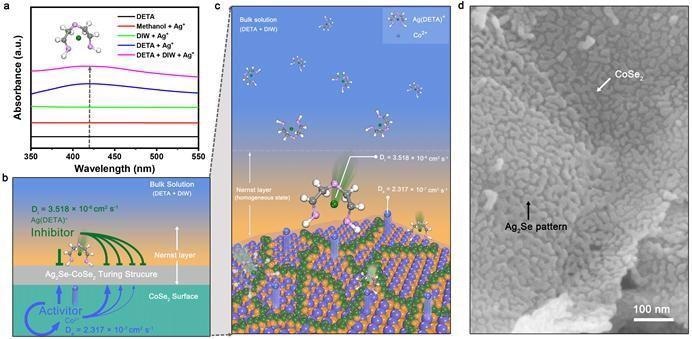Mar 9 2021
Alan Turing, who is considered as the father of computer science and artificial intelligence, hypothesized in 1952 that some repetitive natural patterns may be generated by the interaction of two particular substances via the 'reaction-diffusion' process.
 The reaction diffusion process drove the formation of the complicated inorganic Turing structure. Image Credit: Xiaolong Zhang.
The reaction diffusion process drove the formation of the complicated inorganic Turing structure. Image Credit: Xiaolong Zhang.
As far as this system is considered, activator boosts the reaction and inhibitor prevents the reaction. When the two come in contact, the reaction is diffused.
When the variance in diffusion coefficient between the two gets to a specific level, the high diffusion ratio between them will result in system imbalance and activate the development of periodic complex patterns.
'Turing structure' prevails extensively in nature, like the phyllotaxis of sunflowers, the body patterns of zebras, the follicle spacing of mouse hairs and others. But it is hard to build a Turing structure in an artificial chemical system as the variance in diffusion coefficients of substances is small.
A group of researchers led by Professor Minrui Gao from the University of Science and Technology of China produced, for the first time, the Turing structure on inorganic transition metal chalcogenides by using the 'reaction-diffusion' process.
The study results were reported in a paper published in German Applied Chemistry that was chosen as Hot Paper and Back Cover.
Ag+ in the binary solution of water and diethylenetriamine (DETA) reacts with DETA to form Ag (DETA)+. Meanwhile, Co2+ tends to overflow from the surface of the cobalt diselenide (CoSe2) nanobelt. Co2+ is the activator and Ag (DETA)+ is the inhibitor in this system.
When the quickly diffused Ag (DETA)+ arrives at the Nernst layer on the surface of CoSe2, it interacts with the Co2+ activator diffused on the CoSe2 surface, eventually forming a complex and beautiful Ag2Se Turing pattern on the surface of CoSe2.
The researchers discovered that this multi-interface Turing structure material (Ag2Se-CoSe2) was an efficient oxygen evolution (OER) electrocatalyst. The Ag2Se-CoSe2’s OER activity was linearly associated with the Turing structure’s interface length.
The rich interface structure and the improved OER intermediate adsorption energy at the interface structure combined to induce its high activity.
This research employed the 'reaction-diffusion' theory to develop, for the first time, complex Turing structures on inorganic nanostructured materials. The study offers new concepts for designing low-cost catalysts with higher performance.
Journal Reference:
Zhang, X.-L., et al. ( 2021) An Efficient Turing‐Type Ag2Se‐CoSe2 Multi‐Interfacial Oxygen‐Evolving Electrocatalyst. Angewandte Chemie. doi.org/10.1002/anie.202017016.